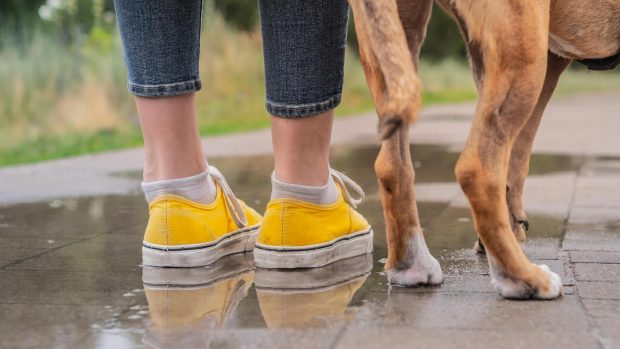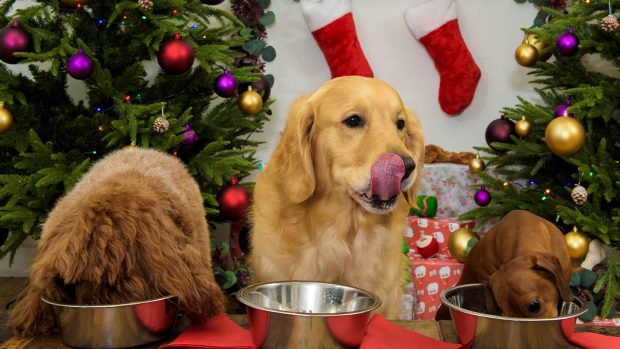First of all, it’s important to recognise that both dogs and children need keeping safe from one another, rather than it just being children that need to be kept safe from dogs. Very rarely will a dog ever harm a child “just because” and nothing is as simple and clear cut as it seems when it comes to dogs and children. Judgements are often made too quickly and usually to the detriment of the dog and the child.
Relationships between children and dogs
The important things to establish in child-dog relationships are respect, kindness, spacial awareness and the understanding of how behaviours from each can have a huge effect on the way they behave towards each other.
I have two boys and they have never known a house without dogs. From the moment they could burble, grab, shuffle, walk, talk and begin to understand the world around them, I started teaching them acceptable behaviour towards dogs and other animals – and I believe this should be the same for all children.
It should be obvious that they are never left together unsupervised. If you have young children and need the toilet, to answer the door or any do other daily chore, then one of them should be with you at all times. It is important to keep them both secure.
What to teach children about dogs
As soon children are able to communicate, it’s important they are able to understand several things – all of which are non-negotiable.
1. Do not sit on a dog, pull, pinch, smack or grab any part of its body.
2. Do not feed the dog from your plate, your hands or tease the dog with food.
3. Do not disturb a dog when it is eating.
4. Do not touch, climb in or shout at a dog in its bed when it is resting or sleeping. If a dog is asleep on the living room floor the same principles apply.
5. Always ask if you can stroke a dog if it is not your own.
6. Do not scare, chase or intimidate dogs.
7. Do not take a dog’s toys unless you are being supervised by an adult in a game of fetch (or another bonding game involving its toys).
8. Dogs do not like being cuddled or grabbed round the neck and hugged, nor do they like being picked up.
9. Do not put your face right in front of a dog’s face and stare at them.
10. Always be calm and kind – how you behave will affect how the dog behaves towards you.
I run courses for children in how to stay safe and behave towards dogs with demonstrations using one of my dogs to show how the behaviour you exhibit affects a dog’s behaviour. I run these in line with and using the Kennel Club Safe And Sound Scheme, which is a program for children to learn and follow. It uses cartoon posters to make it much more appealing and interesting for them.
How to teach dogs to behave around children
This all depends on the personality of your dog and its breed to some extent. I tend to find the smaller breeds are less enthusiastic about children than the medium to large breeds in general. Dogs tend to see children as litter siblings and, therefore, have a tendency to chase and nip feet.
If your dog is overly sociable and exuberant, the first thing to do learn how to stop a dog jumping up and teach them how to be calm. It is extremely easy for an exuberant dog to knock a smaller child over if they are not taught how to behave.
The more reserved dogs, fearful dogs, or dogs that have come to a new home, where they may have been terrorised by children, need you to be their voice. It is imperative from the dog’s point of view that they see you as a person who will keep them safe and speak for them, instead of allowing them to be touched or manhandled. It is OK to say “no, you cannot stroke my dog as it is frightened of children” and this is something I actively encourage my clients to do. They are taught how to handle these situations and make meeting children a positive experience rather than a negative one. The only way a dog can communicate is through body language, growling, backing off or at worse snapping. If this happens, it is you (the owner) at fault for putting both dog and child in a situation that is only going to end badly.
Here are a few pointers to help you train your dog – be it a puppy or an adult dog you have rehomed – to cope and behave around children:
1. Set behavioural expectations and implement manners from the outset, especially if they jump.
2. Get your dog desensitised to children and their noise and energy. Wherever possible, walk them around schools during the lunch breaks and playtime. This goes for the bouncy dogs as well as the scared and nervous ones. Do not do this if a dog has been traumatised by a child.
3. Allow the child and dog to interact in a positive way wherever possible by training, letting them help you to feed the dog, while implementing manners and boundaries on both sides.
4. Have a safe space set aside for your dog even if they are not nervous and shy. It is not sustainable to expect children, especially young ones to not run, shout, and play football and chase with their friends or siblings. If this becomes too over stimulating for a young puppy, this leads to nipping of feet and jumping up to nip – not with malice, but as the puppy would do with a litter sibling when playing and excited. This safe area should not be seen as a punishment for either a scared dog or a playful dog, but more as a sanctuary and a positive place where they can chill with a treat, chew or a lick mat to either calm down or feel safe and secure.
5. Be your dog’s voice. Tell adults and children how they may or may not say hello or stroke your dog. It is your dog and your duty to control them and, more importantly, not put them in a situation where an incident can occur.
When children and dogs live together, all the above-mentioned advice should be implemented. It is beneficial (in as far as the age of the child allows) to include them as much as possible in walks, grooming, picking up after a dog has been to the toilet and the importance of it, preparing feed and joining in the training classes. I always advocate children coming along to puppy class or any other class for that matter and I actively involve them, especially in meet and greets.
Make sure both the dog and the children have their own space that is solely their own. This is needed for both to be able to relax, sleep, eat or chill out. I would also reiterate that no child under the age of 12 should be left alone with a dog unsupervised. A dog’s hormones can be influential – bitches about to come into season can be extremely irritable, pregnant females or ones who have just whelped a litter can turn on a child or an adult if they feel their puppies are in danger. It can be even worse if both the dam and sire are owned and housed together.
Best dog breeds for families
I often get asked what breeds are good for children and my answers may well surprise you! In the many years of doing this job and when asked, I usually ask what size dog you are looking for as that depends on my answers, so based on my opinion only and experience here are my suggestions.
Best small breeds for families
- King Charles Cavalier Spaniel
- Irish Terrier
- Boston Terrier
- Miniature Schnauzer
- Pug
Best medium breeds for families
- Bassett hound
- Golden retriever
- Boxer
- Whippet
- Staffordshire Bull Terriers
Best large breeds for families
- German Shepherd
- Newfoundland
- Rough Collie
- Chesapeake Bay Retriever
- Rottweiler
Best giant breeds for families
- English Mastiff
- Saint Bernard
- Leonberger
- Irish Wolfhound
It may surprise you to note that I have not included Labradors in this list. I am by no means anti-Labrador at all, but statistically they have the highest bite reports. Not all labradors are bred with health, temperament, and welfare in mind. I am lucky enough to teach and work with some wonderful Labrador breeders who go above and beyond for their dogs and when they raise a litter. Raising a litter is vastly different from breeding a litter, but that’s for another day. If you particularly like the idea of a Labrador, do extra research on the breeders and ask lots of questions before buying a puppy.
You might also like:

How to stop your dog jumping up

How do you know if your dog is happy? Canine behaviour expert explains

Signs, causes and coping strategies for reactivity in dogs – explained by an expert

Puppy incoming! How to dog-proof your home ready for the new arrival

Subscribe to Horse & Hound magazine today – and enjoy unlimited website access all year round
Horse & Hound magazine, out every Thursday, is packed with all the latest news and reports, as well as interviews, specials, nostalgia, vet and training advice. Find how you can enjoy the magazine delivered to your door every week, plus options to upgrade your subscription to access our online service that brings you breaking news and reports as well as other benefits.





